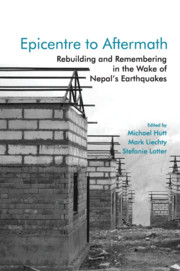9 - Changing Perspectives on International Aid in Nepal since the 2015 Earthquakes
Published online by Cambridge University Press: 08 July 2021
Summary
Introduction
The 2015 earthquakes tested the resilience of Nepali society and the Nepali state to its limits. A fragile regime that was going through a transition from a democratic monarchy to a federal republic and trying to put 10 years of civil war behind it was handed down the mammoth tasks of immediate response and long-term rehabilitation (Hachhethu 2009; Lawoti 2003; Upreti 2006). As expected, Nepal had very little choice other than to turn to its neighbours, friends, and the international community in general for assistance. Help, mostly in the form of relief materials, did arrive, and in large quantities too. But Nepali officials were overwhelmed, and chaos ensued in Nepal's only international airport (PTI 2015). While the government desperately needed aid and assistance from the international community, it also needed to assert control over the situation. Many reports accused the government of creating bureaucratic obstacles which slowed down the flow of aid, and some also alleged corruption (Burke and Rauniyar 2015; Francis 2015), but the other side of the story was that the government also needed to keep checks on potential illegal or inappropriate activities and could not be too lenient with its protocols. As an article published in the Huffington Post (Alfred 2015) pointed out, it was necessary for the government to stay in control and this the government was trying to do. A similar situation continued in the longer term as well, with the government struggling to collaborate efficiently with the non-governmental organizations (NGOs) and international non-governmental organizations (INGOs) which were the recipients of a large percentage of the international aid that was coming into the country. As a step towards controlling the situation, the government eventually introduced a single channel policy for the incoming aid by establishing the Prime Minister's Disaster Relief Fund (Mahatara 2017).
In the longer run, it looked as if the government's and the people's general perception of NGOs and aid agencies was gradually changing after the earthquakes. Discontentment on the part of the government, and changing public views of the activities of I/NGOs and aid agencies, eventually led to the drafting of the National Integrity Policy (NIP) in 2018 (The Himalayan Times 2018b).
- Type
- Chapter
- Information
- Epicentre to AftermathRebuilding and Remembering in the Wake of Nepal's Earthquakes, pp. 203 - 225Publisher: Cambridge University PressPrint publication year: 2021



